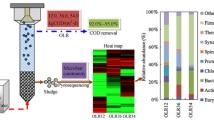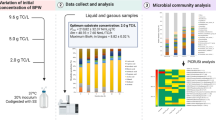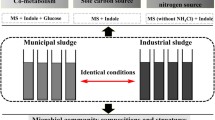Abstract
The Fischer-Tropsch (F-T) process for production of fuels is entrenched in several countries’ approach to meeting energy demands. However, the clean water deficit associated with the down-stream processes has made it necessary to explore bioremediation methods to ameliorate the consequences of its use. In this study, a consortium of bacteria was utilized for determination of biodegradation and removal rates, based on reduction in chemical oxygen demand of a mixture of acetone, propionic acid and hexanoic acid (APH) (all components of F-T wastewater), at an organic loading of 5 and 9.53 g CODL−1. The individual degradation efficiencies of the F-T components were determined using a gas chromatograph. Further, the bacterial consortia responsible for the degradation of the mixture of APH were determined using metagenomics data derived from next-generation sequencing. The overall chemical oxygen demand removal was found to be 88.8% and 82.3% at organic loading of 5 and 9.53 g CODL−1, respectively. The optimal degradation efficiency of acetone, propionic acid and hexanoic acid over a period of 10 days was found to be 100%, 85% and 75.8%, respectively. The primary microbial communities presumed to be responsible for APH degradation by phyla classification across all samples were found to be Proteobacteria (55–92%), Actinobacteria (5–33%) and Firmicutes (0.08–9%). Overall, the study has demonstrated the importance of aerobic consortia interactions in the degradation of components of the F-T wastewater.







Similar content being viewed by others
References
Abatenh E, Gizaw B, Tsegaye Z, Wassie M (2017) Application of microorganisms in bioremediation-review. Jour Environ Microbio 1:1
Abba SI, Elkiran G (2017) Effluent prediction of chemical oxygen demand from the wastewater treatment plant using artificial neural network application. Procedia Com Sci 120:156–163
Ahad N (2016) Removal of carboxylic acids from Fischer-Tropsch aqueous product. University of Alberta, Dissertation
Alalayah W (2017) Biodegradation of wastewater treatment containing petroleum hydrocarbon using rotating biological contractor (RBC). Intern Jour Adv Engin Res Dev 4:58–65
Aljuboury DA, Palaniandy P, Abdul Aziz HB, Feroz S (2017) Treatment of petroleum wastewater by conventional and new technologies-A review. Global Nest Jour 19:439–452
Ambani A, Annegarn H (2015) A reduction in mining and industrial effluents in the Blesbokspruit Ramsar wetland, South Africa: Has the quality of the surface water in the wetland improved? Water SA 41:648–659
Baltrėnas P, Zagorskis A, Misevičius A (2015) Research into acetone removal from air by biofiltration using a biofilter with straight structure plates. Biotechnol Biotechnol Equip 29:404–413
Barba M, Czosnek H, Hadidi A (2014) Historical perspective, development and applications of next-generation sequencing in plant virology. Viruses 6:106–136
Behnami A, Farajzadeh D, Isazadeh S, Benis KZ, Shakerkhatibi M, Shiri Z, Ghorghanlu S, Yadeghari A (2018) Diversity of bacteria in a full-scale petrochemical wastewater treatment plant experiencing stable hydrocarbon removal. Jour of Water Process Engineering 23:285–291
Bourque D, Bisaillon JG, Beaudet R, Sylvestre M, Ishaque M, Morin A (1987) Microbiological degradation of malodorous substances of swine waste under aerobic conditions. Appl Environ Microbiol 53:137–141
Bragg L, Tyson GW (2014) Metagenomics using next-generation sequencing. Environ Microbiol 1096:183–201
Bushell FM, Tonner PL, Jabbari S, Schmid AK, Lund PA (2018) Synergistic impacts of organic acids and pH on growth of Pseudomonas aeruginosa: a comparison of parametric and Bayesian non-parametric methods to model growth. Front Microbiol 9:3196
Cebeci MS, Senturk I, Guvenin U (2016) Investigation of aerobic degradation of industrial wastewater containing high organic matter: kinetic study. Eur Sci J 12:121–132
Chen G, Huang J, Tian X, Chu Q, Zhao Y, Zhao H (2018) Effects of influent loads on performance and microbial community dynamics of aerobic granular sludge treating piggery wastewater. J Chem Technol Biotechnol 93:1443–1452
Chin S, Ismael NS, Abdullar AA, Yahya ARM (2010) Aerobic degradation of volatile fatty acids by bacterial strain isolated from rivers and cow farm in Malaysia. Jour of Biodegradation 1:100–111
Coelho LM, Rezende HC, Coelho LM, de Sousa PA, Melo DF, Coelho NM (2015) Bioremediation of polluted waters using microorganisms. Adv in Bioremediation of Wastewater and Polluted Soil 10:60770
Cole JR, Wang Q, Cardenas E, Fish J, Chai B, Farris RJ, Kulam-Syed-Mohideen AS, McGarrell DM, Marsh T, Garrity GM, Tiedje JM (2008) The Ribosomal Database Project: Improved alignments and new tools for rRNA analysis. Nucleic Acids Res 37:D141–D145
Cydzik-Kwiatkowska A, Zielińska M (2016) Bacterial communities in full-scale wastewater treatment systems. World J Microbiol Biotechnol 32:66
Das N, Chandran P (2011) Microbial degradation of petroleum hydrocarbon contaminants: an overview. Biotechnol Res Int 2011:1–13
De Maayer P, Valverde A, Cowan DA (2014) The current state of metagenomic analysis. In: Poptsova MS (ed) Genome Analysis: Current Procedures and Applications. Caister Academic Press, New York, pp 183–220
Durai G, Rajasimman M, Rajamohan N (2011) Kinetic studies on biodegradation of tannery wastewater in a sequential batch bioreactor. Jour Biot Res 3:19
Edgar RC, Haas BJ, Clemente JC, Quince C, Knight R (2011) UCHIME improves sensitivity and speed of chimera detection. Bioinformatics 27:2194–2200
Ettema TJ, Andersson SG (2009) The α-proteobacteria: the Darwin finches of the bacterial world. Biol Lett 5:429–432
Fritsche W, Hofrichter M (2005) Aerobic degradation of recalcitrant organic compounds by microorganisms. In: Jördening H, Josef Winter J (eds) Environmental biotechnology concepts and applications. Wiley, Germany, pp 203–205
Gaunt P, Hester KW (1989) A kinetic model for volatile fatty acid biodegradation during aerobic treatment of piggery wastes. Biotechnol Bioeng 34:126–130
Hanajima D, Haruta S, Hori T, Ishii M, Haga K, Igarashi Y (2009) Bacterial community dynamics during reduction of odorous compounds in aerated pig manure slurry. J Appl Microbiol 106:118–129
Hung YT, Hawumba JF, Wang LK (2014) Living machines for bioremediation, wastewater treatment, and water conservation. In: Wang L, Yang C (eds) Modern water resources engineering. Humana Press, New Jersey, pp 681–713
Jan B, Beilen V, Neuenschwunder M, Suits TH, Roth C, Balada SB, Witholt B (2003) Rubredoxins involved in alkane degradation. J Bacteriol 184:1722–1732
Jimenez-Diaz L, Caballero A, Segura A (2017) Pathways for the degradation of fatty acids in bacteria. In: Rojo F (ed) Aerobic utilization of hydrocarbons, oils and lipids. Handbook of hydrocarbon and lipid microbiology. Springer, Switzerland, pp 1–23
Joutey NT, Bahafid W, Sayel H, El Ghachtouli N (2013) Biodegradation: Involved microorganisms and genetically engineered microorganisms. In: Chamy R, Rosenkranz F (eds) Biodegradation-life of science. InTech, Croatia, pp 289–320
Jünemann S, Kleinbölting N, Jaenicke S, Henke C, Hassa J, Nelkner J, Stolze Y, Albaum SP, Schlüter A, Goesmann A, Sczyrba A (2017) Bioinformatics for NGS-based metagenomics and the application to biogas research. J Biotechnol 261:10–23
Juretschko S, Loy A, Lehner A, Wagner M (2002) The microbial community composition of a nitrifying-denitrifying activated sludge from an industrial sewage treatment plant analyzed by the full-cycle rRNA approach. Syst Appl Microbiol 25:84–99
Kirby S, Dennis A, Kahler A (2009) Aeration to degas CO2, increase pH, and increase iron oxidation rates for efficient treatment of net alkaline mine drainage. Appl Geochem 24:1175–1184
Kumar S, Babu BV (2008) Separation of carboxylic acids from wastewater via reactive extraction. In: Proceedings of International Convention on Water Resources Development and Management (ICWRDM). Pilani, India
Leung K, Topp E (2001) Bacterial community dynamics in liquid swine manure during storage: molecular analysis using DGGE/PCR of 16S rDNA. FEMS Microbiol Ecol 38:169–177
Liu JF, Mbadinga S, Yang SZ, Gu JD, Mu BZ (2015) Chemical structure, property and potential applications of biosurfactants produced by Bacillus subtilis in petroleum recovery and spill mitigation. Int J Mol Sci 16:4814–4837
Lu X (2012) Fischer-Tropsch synthesis: Towards understanding. University of the Witwatersrand, Dissertation
Lukins HB, Foster JW (1963) Methyl ketone metabolism in hydrocarbon-utilizing mycobacteria. J Bacteriol 85:1074–1087
Majone M, Aulenta F, Dionisi D, D'Addario EN, Sbardellati R, Bolzonella D, Beccari M (2010) High-rate anaerobic treatment of Fischer–Tropsch wastewater in a packed-bed biofilm reactor. Water Res 44:2745–2752
Mittal A (2011) Biological wastewater treatment. Water Today 1:32–44
Mkhize NT, Msagati TA, Mamba BB, Momba M (2014) Determination of volatile fatty acids in wastewater by solvent extraction and gas chromatography. Phys and Chem of the Earth, Parts A/B/C 67:86–92
Muga HE, Mihelcic RJ (2007) Sustainability of wastewater treatment technologies. J Environ Manag 88:437–447
Neethu CS, Saravanakumar C, Purvaja R, Robin RS, Ramesh R (2019) Oil-spill triggered shift in indigenous microbial structure and functional dynamics in different marine environmental matrices. Sci Rep 9:1354
Njalam’mano JBJ, Chirwa EMN (2018) Isolation, identification and characterization of butyric acid degrading bacterium from pit latrine faecal sludge. Chem Eng Trans 64:445–450
Oosterkamp MJ, Boeren S, Atashgahi S, Plugge CM, Schaap PJ, Stams AJ (2015) Proteomic analysis of nitrate-dependent acetone degradation by Alicycliphilus denitrificans strain BC. FEMS Microbiol Lett 362:80
Patil SS, Kumar MS, Ball AS (2010) Microbial community dynamics in anaerobic bioreactors and algal tanks treating piggery wastewater. Appl Microbiol Biotechnol 87:353–363
Penner GB (2014) Mechanisms of volatile fatty acid absorption and metabolism and maintenance of a stable rumen environment. In: 25th Florida Ruminant Nutrition Symposium, vol 4, pp 92–104
Peu P, Béline F, Martinez J (2004) Volatile fatty acids analysis from pig slurry using high-performance liquid chromatography. Int J Environ Anal Chem 84:1017–1022
Platen H, Schink B (1989) Anaerobic degradation of acetone and higher ketones via carboxylation by newly isolated denitrifying bacteria. Microbiology 135:883–891
Quast C, Pruesse E, Yilmaz P, Gerken J, Schweer T, Yarza P, Peplies J, Glöckner FO (2012) The SILVA ribosomal RNA gene database project: improved data processing and web-based tools. Nucleic Acids Res 41:D590–D596
Raju MN, Scalvenzi L (2017) Petroleum degradation: Promising biotechnological tools for bioremediation. Recent Insights in Petroleum Science and Engineering IntechOpen, In
Raza K, Ahmed H (2017) Recent advancement in next generation sequencing techniques and its computational analysis. Int J Bioinforma Res Appl 13:1–14
Riffat R (2013) Fundamentals of wastewater treatment and engineering. CRC Press, London
Rosa R (2017) The role of synthetic fuels for a carbon neutral economy. Jour of Carbon Res 3:11
Schloss PD, Westcott SL, Ryabin T, Hall JR, Hartmann M, Hollister EB, Lesniewski RA, Oakley BB, Parks DH, Robinson CJ, Sahl JW (2009) Introducing mothur: open-source, platform-independent, community-supported software for describing and comparing microbial communities. Appl Environ Microbiol 75:7537–7754
Shen T, Pi Y, Bao M, Xu N, Li Y, Lu J (2015) Biodegradation of different petroleum hydrocarbons by free and immobilized microbial consortia. Environ Sci: Processes & Impacts 17:2022–2033
Shin SH, Lee C, Hwang K, Hwang S (2010) Qualitative and quantitative assessment of microbial community in batch anaerobic digestion of secondary sludge. Bioresour Technol 101:9461–9470
Shokrollahzadeh S, Azizmohseni F, Golmohammad F, Shokouhi H, Khademhaghighat F (2008) Biodegradation potential and bacterial diversity of a petrochemical wastewater treatment plant in Iran. Bio Res Tech 99:6127–6133
Silva CC, Jesus EC, Torres AP, Sousa MP, Santiago VM, Oliveira VM (2010) Investigation of bacterial diversity in membrane bioreactor and conventional activated sludge processes from petroleum refineries using phylogenetic and statistical approaches. J Microbiol Biotechnol 20:447–459
South Africa Department of Water Affairs (2013) Revision of general authorisations in terms of section 39 of the national water act, 1998 (ACT NO. 36 OF 1998) https://cer.org.za/wp-content/uploads/2014/02/Revision-of-General-Authorisations-2013.pdf. Accessed 15 July 2019
Swabey KGA (2004) Evaluation of fluidised-bed reactors for the biological treatment of synthol reaction water, a high-strength COD petrochemical effluent. North-West University, Dissertation
Takeshita T, Yamaji K (2008) Important roles of Fischer–Tropsch synfuels in the global energy future. Energy Policy 36:2773–2784
Tekere M, Lötter A, Olivier J, Venter S (2015) Bacterial diversity in some South African Thermal Springs: a metagenomic analysis. In: Proceedings world geothermal congress 2015. Melbourne, Australia, pp 19–25
Vaidya S, Devpura N, Jain K, Madamwar D (2018) Degradation of chrysene by enriched bacterial consortium. Front Microbiol 9:1333
Van Zyl PJ (2008) Anaerobic digestion of Fischer-Tropsch reaction water: submerged membrane anaerobic reactor design, performance evaluation & modelling. University of Cape Town, Dissertation
Verma I (2018) Metagenomics in the era of Next Generation Sequencing. http://www.sciwri.club/archives/7530.
Volkering F, Breure AM, Sterkenburg A, van Andel JV (1992) Microbial degradation of polycyclic aromatic hydrocarbons: effect of substrate availability on bacterial growth kinetics. Appl Microbiol Biotechnol 36:548–552
Wang Q, Garrity GM, Tiedje JM, Cole JR (2007) Naive Bayesian classifier for rapid assignment of rRNA sequences into the new bacterial taxonomy. Appl Environ Microbiol 73:5261–5267
Wang X, Hu M, Xia Y, Wen X, Ding K (2012) Pyrosequencing analysis of bacterial diversity in 14 wastewater treatment systems in China. Appl Environ Microbiol 1617
Wasewar KL (2005) Separation of lacticacid: recent advances. Chem Biochem Eng Q 19:159–172
Xu X, Liu W, Tian S, Wang W, Qi Q, Jiang P, Gao X, Li F, Li H, Yu H (2018) Petroleum hydrocarbon-degrading bacteria for the remediation of oil pollution under aerobic conditions: a perspective analysis. Front Microbiol 9:2885
Zacharof MP, Lovitt RW (2013) Complex effluent streams as a potential source of volatile fatty acids. Waste and Biomass Valorization 4:557–581
Zhu J, Riskowski GL, Torremorell M (1999) Volatile fatty acids as odor indicators in swine manure—acritical review. Trans of the ASAE 42:175
Funding
IDEAS (UNISA), Department of Science and technology (DST) in partnership with Tata Motors Africa (Student bursary), DST–Bioremediation Research Consortium grant number DST/CON 019/2017 and South Africa Synthetic Oil Liquid (SASOL) Technology University Collaboration provided financial support.
Author information
Authors and Affiliations
Corresponding author
Ethics declarations
Conflict of interest
The authors declare that they have no conflict of interest.
Additional information
Publisher’s note
Springer Nature remains neutral with regard to jurisdictional claims in published maps and institutional affiliations.
Rights and permissions
About this article
Cite this article
Malematja, T.P., Ijoma, G.N., Selvarajan, R. et al. Revealing the bacterial community profiles during the degradation of acetone, propionic and hexanoic acids-components of wastewater from the Fischer-Tropsch process. Int Microbiol 23, 313–324 (2020). https://doi.org/10.1007/s10123-019-00106-z
Received:
Revised:
Accepted:
Published:
Issue Date:
DOI: https://doi.org/10.1007/s10123-019-00106-z




